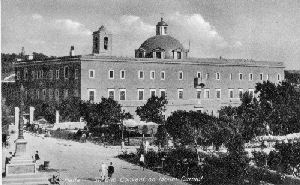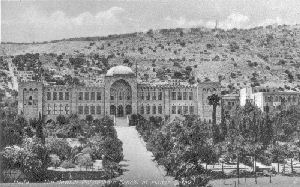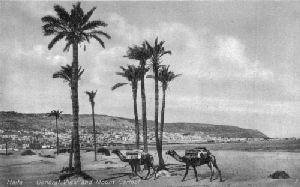| This
database contains details of British casualties during the Palestine
Conflict Sept 1945- Dec 1948. There are some officials and policeman
also included. This is not the full list of casualties but has the
vast majority in it. One of the great dramas in British imperial
history, the strife-torn three decades of British rule in Palestine,
known as the Mandate (1917-1948), remain controversial even now.
The British Mandate in Palestine, which was granted after World
War 1, was due to expire in 1948. Peaceful progress towards self-government
for the region was impossible and the British Army found itself
in the middle of a power struggle between Arab and Jewish inhabitants
and was being attacked by both sides. This database details the
British lives lost in the years following World War 2 and the run
up to the creation of the states of Israel and Jordan and the splitting
of the Arab lands.
Database
contains 915 records -
17 June, 2025
|
Most
of those who died are either buried in Ramleh War Cemetery, Israel,
Jerusalem Protestant Cemetery, Israel, Sharon British Civil Cemetery,
Haifa, Israel or Khayat Beach War Cemetery, Israel. Details for
those who died have been extracted from the Commonwealth
War Graves Commission web site for 1945 to 1947. There
is also a searchable
veterans database for those who died after World War 2.
Timeline:
1945
Arab League (League of Arab States) established. Formed to express
the economic and security needs of Arab states. First founded with
7 Arab states; In 2004, it has 22 members.
1946
Anglo-American Committee of Inquiry. American and British collaboration
formed to address the Arab-Israel conflict and Jewish refugees and
survivors of the Holocaust.
1946
Morrison-Grady Plan for Palestine. Report by Britain's Herbert Morrison
and United States' Henry Grady calling for a semi-autonomous Palestine
divided into Jewish and Arab regions. Limits Jewish immigration
to 100,000 in the first year, then to be determined by Britain,
with Britain controlling the military, foreign relations, immigration,
and customs. Rejected by both the Jews and Arabs.
1946
Anglo-American Conference (second Bludan Conference). Arab League
meets to discuss Anglo-American Committee of Inquiry report. They
criticize American interference in Palestine, suggest a boycott
of Jewish goods, and vow to help the Palestinian Arabs.
1946
France leaves Syria and Lebanon; British end Mandate over Transjordan.
1947
United Nations votes partition plan (Resolution 181). Award Jews
a homeland in Palestine. With one-third of the population and 7%
of the land ownership, Jews are awarded 55% of Palestine. The plan
is violently rejected by Arab Palestinians.
1948
Dayr Yasin (Deir Yasin) massacre. Surprise attack and massacre on
Palestinian village outside Jerusalem kills 105 to 205 people and
leaves the village in ruins. Conducted by Jewish paramilitary units,
National Military Organization (led by Menachem Begin) and Fighters
for the Freedom of Israel.
1948
British Mandate on Palestine expires on 14 May. British relinquish
Mandate. Next day Jews proclaim the independent State of Israel.
David Ben-Gurion, the Zionist leader, becomes Israel's first prime
minister. Neighboring Arab countries send in troops to combat the
Jews as British depart.
1948–1949
Arab-Israel war; known as Nakba to the Arabs and the War of Independence
to the Jews. In Arabic, Nakba means "disaster" or "catastrophe."
This war over the establishment of an Israeli state in Palestine
results in the displacement of 700,000 to 750,000 Arabs (more than
half the Arab population in the Mandate), confiscation of property,
massacres, and the loss of a Palestinian homeland and society. Neighboring
Arab countries (Lebanon, Syria, Jordan, Egypt, and Iraq) come to
the aid of the Palestinians. Israel extends its boundaries by about
2,500 square miles.
1948
Count Folke Bernadotte assassinated; UN General Assembly passes
Resolution 194. Bernadotte, a United Nations mediator in Israel
and Palestine, proposes a truce between Arabs and Jews, which is
broken and restored several times. In the two versions of the Bernadotte
Plan for Arab-Israeli Settlement, boundaries are proposed in which
Jerusalem goes to Transjordan (version 1) or is placed under United
Nations control (version 2). Displaced Palestinians are offered
repatriation or compensation for resettlement. Israel is to be recognized
as an independent state. Both Arabs and Israelis reject his plan.
On September 17, Bernadotte is gunned down by the Israeli group
LEHI in Jerusalem.
1948
All-Palestine government; Palestine declaration of independence.
In response to the formation of the Israeli state, the Palestinians
declare the need for an Arab government to represent and defend
their interests. It is backed by surrounding Arab countries, but
ultimately is ineffective.
1949
General armistice agreements between Israel and Egypt, Jordan, Syria,
and Lebanon. Peace agreements, sponsored by the United Nations and
mediated by Ralphe Bunche, put an end to the 1948 Arab-Israel War.
Timeline
Source: Dictionary of the Israeli-Palestinian Conflict.
Vol. 1. Detroit: Macmillan Reference USA, 2005. p227-236.
2 vols.
 |
Haifa,
St Elie Convent on Mount Carmel |
 |
Gaifa,
The Jewish Polytechnic School at Hadar Carmel |
 |
Haifa,
General View and Mount Carmel |
|